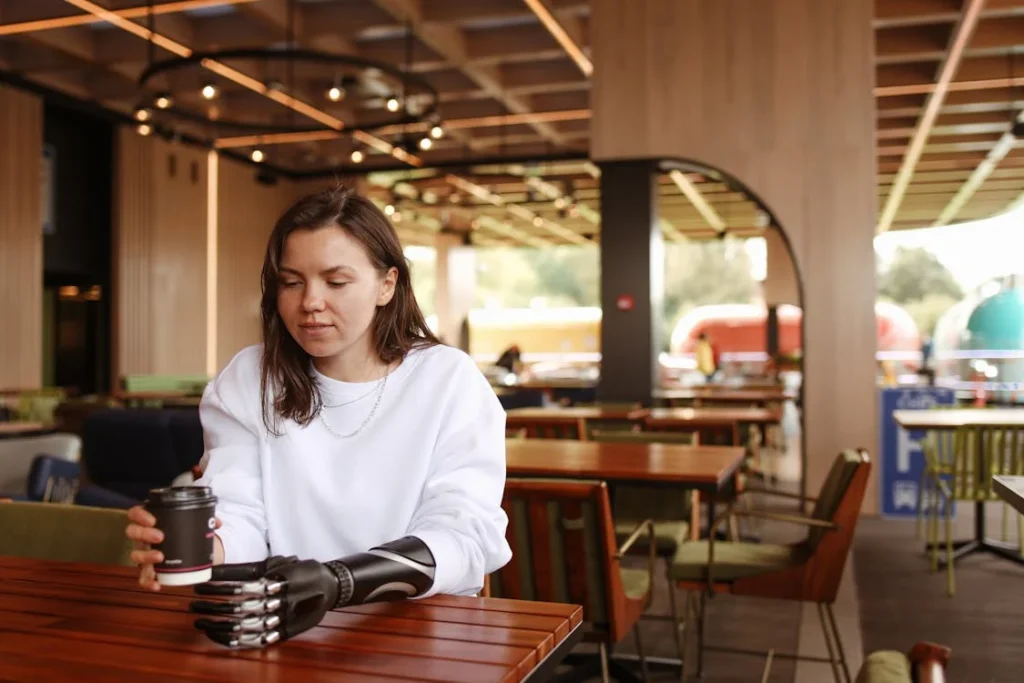Rehabilitation after limb loss isn’t just about learning to walk again or training a new arm to move. It’s about building habits. Daily, deliberate habits. And not just doing them once or twice a week—it’s about showing up every single day until it becomes second nature. But let’s be honest: sticking to a rehab routine is tough. The exercises can feel boring. Progress can feel slow. And when there’s no spark of motivation, it’s easy to skip “just this once.”
This is where game design psychology can change everything.
Game design isn’t about cartoons, flashing lights, or meaningless rewards. It’s about understanding what keeps people coming back. It’s about turning small tasks into meaningful, satisfying steps. It’s about building systems that turn practice into progress, and progress into purpose.
At Robobionics, we work with prosthetic users of all ages and backgrounds across India. We know how challenging daily rehab can be. But we also know that with the right mindset—and the right structure—it can become something empowering. Even enjoyable.

The Psychology Behind Why Games Work—and What Rehab Can Learn
Understanding What Makes People Come Back Again and Again
If you’ve ever found yourself glued to a mobile game, or watched someone else obsess over leveling up, you’ve already seen game design psychology in action. It isn’t magic—it’s structure. Games work because they are built to make people feel something consistently. Not just excitement, but achievement, progress, and purpose. The best games give you clear goals, immediate feedback, and a steady sense of momentum. They meet you where you are and guide you forward without making you feel lost or judged.
Now imagine taking those same ideas and applying them to your daily rehab.
At its heart, game design psychology is about tapping into human motivation. People want to feel like their actions matter. They want to feel capable. And they want to see how far they’ve come. Traditional rehab doesn’t always do this well. You stretch, hold, move, and repeat—but there’s often no visible sign that today was better than yesterday. That’s where game principles come in and fill the gap.
When a game sets a small goal and rewards you for reaching it, your brain releases a chemical called dopamine. It’s a natural reward that says, “Well done. Keep going.” That’s how games keep people hooked. Rehab can—and should—do the same.
The Power of Tiny Wins
One of the most powerful ideas in game design is the micro win. In most games, you don’t have to wait hours to feel progress. You collect coins, complete short quests, beat mini-challenges. Every few minutes, there’s something small that reminds you: you’re moving forward.
In rehab, that’s often missing. The big goal—walking without help, using your prosthetic to cook, climbing stairs—can feel so far away. That gap between where you are now and where you want to be can feel overwhelming. That’s why breaking rehab into smaller, meaningful milestones is critical.
Imagine if, instead of doing ten reps and stopping, your rehab included a simple feedback system that showed you moved your arm 3 degrees farther than yesterday. Or held your balance for 10 seconds longer. Those are real, measurable wins. They matter. And if you track them—on paper, on an app, or with a device—they start building a story of growth.
Every win tells you: you’re getting better. And those tiny moments, repeated daily, become the fuel that powers long-term recovery.
Setting Daily “Quests” Instead of “Tasks”
Another clever idea from game design is how goals are framed. In most rehab plans, patients are given a set of exercises. Often, it’s a checklist: “Do 3 sets of 10 shoulder raises. Walk for 15 minutes.” It’s helpful, but it feels clinical. Mechanical. There’s no story behind it. And for many people—especially when they’re tired, frustrated, or scared—that kind of structure isn’t very inspiring.
Now think about how games frame goals. They don’t say, “Move your character forward 20 steps.” They say, “Get through the maze to find the lost treasure.” Or, “Rescue the trapped explorer.” Even silly stories can give actions meaning. It turns a chore into a mission.
Rehab can borrow this. A simple reframe can shift the way a task feels. Instead of “3 sets of shoulder raises,” you could call it “Unlocking joint flexibility to prep for daily tasks.” That might sound small, but it changes how your brain relates to the action. Suddenly, it’s not a rep count—it’s part of a story where you’re the hero regaining strength.
At Robobionics, we often encourage users to write down their own quests each morning. Not as random motivational slogans, but as a commitment to a personal mission. “Today, I’m rebuilding control in my right arm.” “Today, I’m conquering balance for evening walks.” Those are real-life quests. They create emotional weight behind your routine—and that’s what makes it stick.
Feedback Loops: Why Immediate Results Matter
In most games, when you do something, the game responds. You hit a button, and the screen changes. You land a move, and your character reacts. This instant feedback keeps you engaged. It lets you know you’re doing something right—or nudges you to adjust if you’re not.
Now think about your rehab sessions. Do you know, in real time, if your posture is improving? Can you feel if your movement range has expanded? Often, the answer is no. And without feedback, your brain loses interest. That’s one reason why rehab can start strong and then fizzle out over time.
Bringing feedback into your daily ritual is essential. If you’re working with a smart prosthetic, use its data. If not, even a simple wall chart or motion tracking app can give you insights. For example, mark how far your arm reaches each morning. Record how long you can stand on your prosthetic without holding a rail. The moment you see improvement, you start to crave more of it. That’s the loop: action → feedback → motivation → repeat.
And remember, feedback doesn’t always have to be visual. It can also come from how you feel. Is today’s exercise easier than yesterday’s? Did you recover faster? Reflecting on your experience, even for just one minute a day, helps close the loop and gives your mind a sense of satisfaction.

Making Rehab a Ritual—Not Just a Routine
Rituals Begin With Meaning, Not Motion
There’s a reason why certain habits stick with us, while others fade after just a few days. When an action becomes a ritual, it’s tied to emotion, identity, and purpose. You’re not just doing something because you’re told—it becomes something you choose to do because it reflects who you are or who you want to become.
Daily rehab often starts as a routine. You do it because you have to. You show up because your therapist or doctor said it’s important. But routines, by themselves, can feel hollow. They can feel like a chore. A ritual, on the other hand, has weight. It feels personal. It brings intention into each moment.
To turn your rehab into a ritual, start by defining why it matters to you. Not what the medical books say. Not what your physiotherapist recommends. But what you are hoping to reclaim. Maybe it’s walking to your neighbor’s house without help. Maybe it’s being able to hug your grandchild with full strength. Maybe it’s cooking with your own hands again. Let that vision shape the way you begin each session.
Before you even stretch or move, take a breath and quietly remind yourself why you’re here. That pause turns exercise into meaning. And that’s the first step to ritual.
Timing and Triggers: How Rituals Stay Consistent
Games are often played at the same time each day. Not because they’re scheduled, but because players unconsciously build a rhythm. Rehab can use the same principle. If you do your session at a random time each day, your brain doesn’t know when to expect it. But when rehab happens after your morning tea, or before your afternoon walk, it begins to anchor itself into your daily rhythm.
That “anchor” is called a trigger. In game design, triggers are everywhere—alerts, sounds, light changes. These are cues that tell the player, “It’s time to return.” You can create these in your rehab environment too. A specific song that plays before you begin. A dedicated chair or mat that signals, “This is where I work on myself.” Even a light scent from a diffuser or oil can become a signal. It tells your brain, “This is my rehab space, and this is my moment.”
And once that trigger becomes familiar, your brain begins to anticipate it. You may even start looking forward to it. That’s the quiet beauty of ritual. It moves from “something I have to do” to “something I get to do.” That mindset shift keeps you consistent—not out of obligation, but out of choice.
Building Momentum With a Personal Narrative
Game designers are masters of momentum. They know that the early moments in any journey are the most fragile. If the user feels lost or overwhelmed, they’ll quit. So games start small, offer early wins, and slowly raise the challenge. That early success builds confidence, which builds momentum.
You can apply this exact strategy to your rehab ritual.
In your first week, don’t aim for perfection. Aim for presence. Show up. Move gently. Let your body wake up. Focus more on the feeling of starting than on how far you go. Because once you’ve started, the rest becomes easier.
Each week, reflect on your narrative. Where were you seven days ago? What can you do now that felt difficult then? Write it down. Speak it aloud. Tell someone close to you. These little stories help you see your progress—not just in stats, but in identity. You’re no longer someone recovering. You’re someone who shows up, who moves forward, who grows.
And when you string those stories together—day by day, week by week—you begin to build a new version of yourself. Stronger. More confident. More in control. That’s what momentum feels like.
Embracing Setbacks Without Losing the Ritual
Even in the best-designed games, players hit walls. They fail a level. They run out of lives. But here’s what good game design teaches us: failure isn’t the end. It’s part of the journey.
In rehab, you’ll have days when nothing feels right. The pain might flare up. The exercises may feel harder than usual. Maybe your mind just isn’t in it. That’s okay. The key is not to abandon the ritual.
On low days, scale back. Don’t stop completely. Do just one movement. Or spend five minutes visualizing your motions if you can’t do them physically. These small actions protect the rhythm you’ve built. They remind you: even on hard days, I am still in this.
And when you return fully, you’ll find that your ritual waited for you. That continuity—through both the highs and lows—is what transforms rehab into something lasting. Not a temporary program, but a lifelong foundation of care, discipline, and self-respect.

Designing Your Environment Like a Game World
Why Your Space Shapes Your Success
In games, environments are designed to support action. Every space serves a purpose. You enter one room to build, another to rest, another to level up. The environment is never random. It gives the player cues about what to do next and how to feel while doing it. Your rehab environment should work the same way.
Many people overlook the power of their surroundings. They try to squeeze rehab in between kitchen counters or awkward living room corners. The result? Discomfort, distraction, and ultimately—disengagement. But when you give your rehab space its own identity, it begins to support you, not just contain you.
You don’t need expensive equipment or a massive room. What you need is intentionality. Create a space that feels like it was made for growth. A quiet corner. A favorite chair. A yoga mat that stays unrolled. A place where your tools—like resistance bands, balance boards, or a simple notebook—are always within reach. When everything is in its place, your brain doesn’t have to negotiate or delay. You just begin.
Over time, this space becomes sacred. The moment you step into it, your body knows what to do. It’s not just a physical space—it becomes a mental one. A world where you reconnect with your goals, your discipline, and your belief in yourself.
Sensory Design: Engaging More Than Just Muscles
Games don’t just use visuals. They use sound, motion, and even haptic feedback to create immersion. This sensory engagement deepens emotional connection. You feel like you’re in the experience, not just going through the motions.
Your rehab ritual can be enriched the same way. Consider what you hear, smell, and feel while you move. Background music can set the tone—calming on days you’re anxious, energizing when you feel slow. A familiar scent, like sandalwood or lavender, can signal the start of focus. Comfortable lighting—not too harsh, not too dim—can lift your mood.
These details may seem small, but they add up. They tell your nervous system: this is a safe, encouraging space to push yourself. When your environment supports your senses, your rehab becomes more than just physical repetition—it becomes a mindful practice. Something you want to return to. Something that feels good.
Creating Visual Markers of Progress
One of the most addictive parts of any game is the ability to see how far you’ve come. Whether it’s a level bar, a trophy case, or a virtual map that fills in over time, visual progress keeps players engaged. It gives the journey a shape. A story.
Your rehab ritual needs the same kind of reinforcement. Not hidden in a folder. Not buried in a clinical chart. But right in front of you.
Put up a calendar. Use stickers, checkmarks, or even sketches to mark each day you complete a session. Post notes with your best times, your strongest effort, your proudest improvement. If you’ve regained a motion you couldn’t do last month, write it down in bold.
When your progress is visible, it stays present. You walk past your wins every day. You see them. You remember them. And when you hit a tough patch—and you will—you’ll have a wall of proof that you’ve done hard things before. You can do them again.
This visible progress also becomes a silent invitation to others. When family members see your chart, they’re more likely to ask, “How was rehab today?” That simple question can make you feel seen. Valued. Supported.
Integrating Ritual Into Real Life
Game worlds feel alive because they mirror the real world in small, clever ways. The timing of rewards, the rhythm of the story, the pacing of challenge and rest—it all mimics life, just a little more structured. You can design your rehab to blend seamlessly into your real life, too.
For example, if you’re working on standing balance, do your session near the kitchen before preparing your morning tea. If your goal is upper limb control, pair your rehab with folding laundry or organizing your desk. When your ritual overlaps with real-life activities, it becomes more functional—and less like something separate or artificial.
And here’s the beauty of that: when rehab stops feeling like a break from life, and starts becoming part of life, it becomes sustainable. Not because you’re constantly grinding, but because you’ve built an ecosystem where rehab supports who you are, not just what you need to fix.
Your space, your time, your senses, your rituals—all working together like a beautifully designed game world. A place where you grow stronger every day.

Building Your Own Reward System That Actually Works
Why External Motivation Isn’t Enough
Most rehab plans start with motivation—usually the kind that comes from outside. A doctor says you need to move more. A therapist gives you a list of exercises. Family members check in and remind you. In the beginning, that’s enough to get going. But over time, those reminders fade. The real question becomes: what makes you want to keep going, even when no one is watching?
In games, rewards keep players coming back. Not because they’re forced, but because they want that next level, that next skin, that next badge. It taps into a deeper part of the brain—the part that lights up with achievement. The part that says, “Look what I did.”
Rehab needs the same kind of internal reward system. It’s not about gold stars or praise from others—it’s about building a pattern where progress feels good. When you begin to associate movement with pride, with progress, and even with joy, that’s when true habit begins to form. That’s when you no longer need reminders—because the process itself becomes its own kind of reward.
Designing Meaningful Milestones
Game designers are intentional about when and how players receive rewards. Early milestones come quickly to build confidence. Later ones require more effort but feel more satisfying. Each reward is timed to match effort and keep the player engaged. Rehab rituals should be structured the same way.
Start with short-term, meaningful milestones. Not vague ideas like “get stronger” but specific actions you can track. “Complete five sessions this week.” “Hold balance for 20 seconds.” “Use the prosthetic to pick up a small object without dropping it.”
Celebrate those wins in your own way. It could be writing it on a sticky note and placing it on your mirror. It could be enjoying a favorite treat after a week of consistent practice. It could even be taking a photo of your progress and saving it in a private folder.
The key is to create moments of acknowledgment. Don’t wait for someone else to applaud. Be your own biggest cheerleader. The more you recognize your own milestones, the more likely you are to pursue the next one.
Gamify the Rewards, Not Just the Effort
It’s easy to focus all your energy on the exercises—on form, on precision, on performance. But games remind us that the after matters too. When a player finishes a tough level, the game doesn’t just move on. It celebrates. It flashes colors. It plays sounds. It pauses to say: “You did it.”
You can build similar pauses into your rehab. After completing a challenging movement or reaching a personal best, stop. Take a moment. Smile. Say something kind to yourself. Play your favorite song. Sip your tea slower. Feel the reward. These rituals may seem small, but they matter.
You’re teaching your brain that effort = reward. That your hard work is worth noticing. That mindset builds resilience, especially on the days when progress is slower. You’ll remember that a reward is always around the corner—even if it’s just a small emotional lift.
Some people also enjoy adding light gamified tools to track sessions. A mobile app, a printable calendar, even a color-coded wall chart. These visuals turn streaks into stories. They give your ritual a narrative—a visible reminder that you’re on a winning streak. And when you miss a day, no guilt—just get back in and keep writing your story.
Avoiding the Trap of Perfection
One of the risks with rewards is tying them too tightly to perfect performance. In games, even if you fail, you get another try. You learn something. You still move forward. That resilience is part of what makes game loops powerful—they don’t expect perfection. They expect progress.
Your rehab ritual should carry the same expectation. You will have off days. There will be movements you can’t quite master. You might forget a session, or feel too sore to finish. But none of that means you’ve failed. It just means you’re human.
Reward effort, not just results. Celebrate the fact that you showed up. That you tried. That you moved your body and honored your commitment. These moments matter more than the number of reps or the range of motion. They’re the glue that holds your ritual together.
And remember: real rewards don’t need to be flashy. They just need to feel true. The quiet satisfaction after a focused session. The relief in your muscles. The moment you realize something that felt impossible last month is now your warmup. These are the true wins. The ones that stay with you.

Turning Rehab Into a Personal Legacy
Why Your Ritual Isn’t Just for You
When you commit to a daily rehab ritual, you’re doing something deeply personal—but also something that echoes far beyond yourself. You are building a legacy of strength, consistency, and self-leadership. Whether you realize it or not, the people around you are watching. Family members, friends, caregivers—they see you showing up day after day. And in that quiet repetition, you’re teaching something powerful: healing takes time, but it’s worth it.
Think about younger people in your life. Maybe it’s your children. Maybe it’s a neighbor or a student who looks up to you. They may not say anything aloud, but when they see your effort, your commitment, your refusal to give up, it becomes a lesson. You are showing them what it means to persevere. That example—lived, not preached—can have more impact than any advice ever could.
Even if you live alone, even if you don’t see many people each day, your ritual creates something real. A rhythm of resilience. A story of progress. And those stories, when written down, when remembered, when shared—become a map for others who may one day walk a similar path.
Documenting Your Journey, One Day at a Time
Games track everything. How many hours played. Which levels completed. Where you struggled and where you soared. This creates a rich history—a timeline of growth. Your rehab ritual deserves the same care.
Consider keeping a simple journal. Not just a record of what exercises you did, but how you felt. What was hard today? What came easier? Did you discover something about your prosthetic you hadn’t noticed before? Did your body surprise you in some small way?
Over time, this log becomes more than just a diary. It becomes a record of transformation. On days when motivation runs low, looking back on past entries can reignite your drive. You’ll remember how far you’ve come—and you’ll want to keep going, just to see what happens next.
And one day, someone else—perhaps another prosthetic user just starting their journey—may benefit from your notes. Your thoughts. Your hard-earned wisdom. This is the quiet power of legacy: we struggle today, so someone else struggles less tomorrow.
Sharing Without Performing
We live in a world where progress is often shared online, sometimes for approval, sometimes for validation. That can be motivating—but it can also be exhausting. You don’t have to post your rehab ritual on social media to make it real. You don’t need likes or comments for your effort to matter.
Instead, focus on sharing your story in ways that feel grounded. A conversation with a friend. A quiet moment with your therapist. A letter to yourself. A note for your grandchild. These small acts of sharing are honest. They come from reflection, not performance. And they create a deeper kind of connection.
You might be surprised at how many people are moved by your honesty. Your vulnerability. Your truth. In sharing the journey—the pain, the progress, the patience—you give others permission to do the same.
Becoming the Hero of Your Own Narrative
Games are built around heroes. The characters face trials, make sacrifices, find their strength, and eventually overcome. Rehab is no different. You are not a patient waiting to be fixed. You are the main character. You are in motion, in choice, in transformation.
Each day you show up to your ritual, you are taking the next step in that story. Some days, the step is big. Some days, it’s barely a shuffle forward. But it’s forward. And that matters.
Begin to see your ritual as a narrative arc. Where were you at the beginning? Where are you now? Who did you have to become to make this commitment daily? The answers to those questions are more powerful than any score, any data point, any measurement of physical strength.
Your identity is being shaped in motion. Not by perfect performance, but by repeated effort. That’s what heroes do. They keep moving, even when the path is hard. They grow stronger, not by avoiding challenge, but by walking through it.
And when others hear your story—through your words, your actions, or simply by watching you—they’ll feel a little braver too.

Mood Mapping: Using Emotion to Shape Your Rehab Experience
How Your Emotional State Shapes Physical Progress
Most people think rehab is all about muscles, joints, and repetition. But at Robobionics, we’ve seen something else just as important—mood. The way you feel during a session plays a huge role in how well your body responds to movement. On good days, you’re confident, focused, and open to challenge. On bad days, you’re distracted, tired, maybe even a little hopeless. And when those feelings go unmanaged, they can quietly erode your progress over time.
Games know this better than anyone.
In fact, modern games are designed to respond to your emotional state—sometimes in subtle ways. If a player is losing too often, the game will ease up a little. If they’re bored, it increases the challenge. This is called dynamic difficulty adjustment, and it keeps players in the sweet spot: not too easy, not too hard. Just right. Rehab rituals can benefit from the same logic.
Start by paying attention to how your mood shifts throughout the day. You might feel sharper and more energetic after breakfast. Or calmer and more grounded in the late afternoon. Choose your rehab time to match those moods, not just your schedule. Rehab is more effective when it works with your emotional rhythm—not against it.
Designing Emotional Checkpoints
In games, there’s usually a safe zone between battles or big decisions—a space where the player can pause, heal, and prepare for what’s next. These aren’t just breathers. They’re emotional checkpoints. And your rehab ritual needs them too.
Before each session, take one minute to ask: How am I feeling right now? Are you tense? Frustrated? Energized? Disconnected? This isn’t just fluff—it’s data. Because your emotional state determines how hard you should push, what kind of music to play, what tone to set.
If you’re feeling low, choose a gentle session. Let the focus be on breath and presence. If you’re feeling strong, take on a more challenging sequence. Let the session be about growth and progress. When you tailor the emotional tone to match your mental state, your brain stays more engaged. Your body follows.
Some users find it helpful to create two or three “mood modes” for rehab. A calm mode. A power mode. A recovery mode. Each one with a different playlist, lighting setup, and goal. You don’t need fancy equipment—just consistency. When you enter each mode, your body will start to recognize it, and respond faster.
Using Micro-Narratives to Shape Emotional Flow
Every game has a story—even if it’s simple. That story gives players a reason to keep going. It answers the question: Why am I doing this?
Your rehab ritual can use micro-narratives to give emotional weight to each session. Not long, complicated ones. Just short internal stories you tell yourself as you move. On some days, it might be: “Today I’m training like a soldier.” On others: “Today is about healing gently, like watering a plant.” These stories give shape to your effort. They turn abstract motion into emotional action.
It might sound silly at first—but it works. You’re not just doing a shoulder stretch. You’re building armor. You’re not just balancing on your prosthetic leg. You’re learning how to stand tall again after a storm. That narrative connection deepens emotional investment. It makes every session feel yours.
Recovering from Emotional Fatigue
Sometimes the hardest days aren’t the physically painful ones—they’re the emotionally heavy ones. You feel stuck. You’ve been doing everything right, but progress feels slow. Or something else in life—an argument, bad weather, a poor night’s sleep—just drags you down.
In games, players sometimes take a break. They log off, not because they’re quitting, but because they need time to reset. That’s healthy. Your rehab ritual should give you that freedom too. Missing one day isn’t failure—it’s emotional recalibration. But when you return, make your comeback intentional.
Have a ritual for your “return” days. A slower pace. A different soundtrack. A personal message you write to yourself: “Even after rest, I rise.” These moments are powerful. They mark resilience. And they remind you that the emotional part of rehab is just as worthy of attention as the physical.
When you treat emotion as part of your plan—not as a distraction from it—you begin to move through recovery with more self-trust, more fluidity, and more grace.
conclusion
Rehabilitation is often treated as something temporary. A phase. A task to complete before “life goes back to normal.” But for many prosthetic users—especially those rebuilding strength, balance, and mobility from the ground up—recovery is not a pit stop. It’s a transition into a new kind of life.
That’s why we believe so deeply in building a daily rehab ritual using game design psychology. Because this isn’t just about helping you move again—it’s about helping you live again. Fully. Actively. With intention. With pride.
When you treat your daily rehab like a quest—designed with care, filled with feedback, enriched with emotion—you stop chasing distant outcomes and start finding joy in the process. You stop counting reps and start creating meaning. You’re no longer doing something to “get better.” You are getting better, one day at a time, because you’ve designed your life to support it.
At Robobionics, we don’t just build prosthetics. We build experiences. We build tools. And more than anything, we build belief—belief that your journey can be powerful, personal, and even playful.
Your rehab ritual isn’t just about function. It’s about freedom. And the more you design it with purpose, the more that freedom becomes part of who you are.
You’re not just recovering—you’re leveling up.



